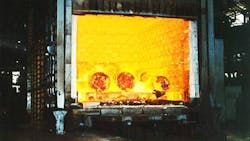CAS DataLoggers' standalone devices automatically record process temperatures with no need for human intervention, increasing measurement accuracy and freeing up operators for other work. As in the recent example of a plant that converted a manual data-collection system for an installation with multiple stationary heat treating ovens, the customer’s previous procedures required employees to read temperature values periodically from several controller displays, and manually record them using paper forms.
This turned out to be an inefficient and unreliable way to document the ovens’ temperature profile. The manufacturer needed to reduce data-entry errors and cut wasted time while increasing measurement accuracy and quality, in order to provide the most precise reporting to end customers.
The plant installed dataTaker DT80 data loggers in control cabinets near their ovens, using repeated signals from the existing temperature controllers as inputs. These standalone dataloggers now automatically record process temperature without the need for human intervention, which increases measurement accuracy and frees everyone for other important work.
Now, the users have only to glance at each logger’s integrated display. All measurements are stored in each device’s user-defined memory (up to 10 million readings), and can also be saved to a memory stick via the logger’s USB port. It’s easy to set schedule size and mode to record only as long as necessary and overwrite or stop logging once each DT80’s memory is full.
Each dataTaker also features a solid construction to protect it from the occasional industrial mishap or being dropped.
The dataTakers are connected to the plant LAN via Ethernet so data transmission is performed by FTP to a local server. Using the included dEX graphic interface, Quality Assurance engineers access calculations and diagnostic information and can view the data in dashboards, charts and tables.
Users learned quickly how to configure and setup in dEX, to customize data collection. They can monitor process data remotely, from anywhere an Internet connection is available.
Similarly, automated alarm messages notify personnel over FTP whenever temperatures went outside these user-set parameters, and this also triggered the loggers to archive the data.
After installation, the dataTakers removed the need to take manual measurements, saving employees many hours of walking around with a clipboard and taking all the data down by pen. Data collection, transmission and alarming are all automated so no one has to take time out of their day to check temperatures, record the data, or report an alarm.
Through standalone operation, the dataTakers continue to operate during power failures. The developer provides free tech support for set-ups and implementing scheduling and control tasks.
Visit www.dataloggerinc.com
